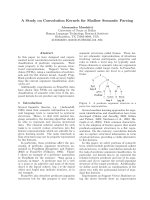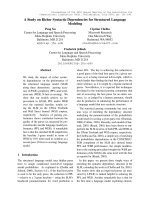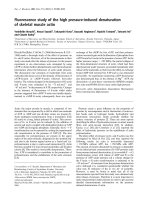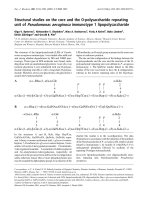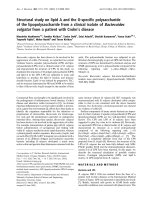Báo cáo y học: "Comparative study on saponin fractions from Panax notoginseng inhibiting inflammation-induced endothelial adhesion molecule expression and monocyte adhesion" docx
Bạn đang xem bản rút gọn của tài liệu. Xem và tải ngay bản đầy đủ của tài liệu tại đây (1.44 MB, 37 trang )
This Provisional PDF corresponds to the article as it appeared upon acceptance. Fully formatted
PDF and full text (HTML) versions will be made available soon.
Comparative study on saponin fractions from Panax notoginseng inhibiting
inflammation-induced endothelial adhesion molecule expression and monocyte
adhesion
Chinese Medicine 2011, 6:37 doi:10.1186/1749-8546-6-37
Nan Wang ()
Jian-Bo Wan ()
Shun-Wan Chan ()
Yan-Hui Deng ()
Nan Yu ()
Qing-Wen Zhang ()
Yi-Tao Wang ()
Simon Ming-Yuen Lee ()
ISSN 1749-8546
Article type Research
Submission date 20 May 2011
Acceptance date 13 October 2011
Publication date 13 October 2011
Article URL />This peer-reviewed article was published immediately upon acceptance. It can be downloaded,
printed and distributed freely for any purposes (see copyright notice below).
Articles in Chinese Medicine are listed in PubMed and archived at PubMed Central.
For information about publishing your research in Chinese Medicine or any BioMed Central journal,
go to
/>For information about other BioMed Central publications go to
/>Chinese Medicine
© 2011 Wang et al. ; licensee BioMed Central Ltd.
This is an open access article distributed under the terms of the Creative Commons Attribution License ( />which permits unrestricted use, distribution, and reproduction in any medium, provided the original work is properly cited.
Comparative study on saponin fractions from Panax notoginseng
inhibiting inflammation-induced endothelial adhesion molecule
expression and monocyte adhesion
Nan Wang
1, 2, 3
, Jian-Bo Wan
1, 2
, Shun-Wan Chan
4
, Yan-Hui Deng
1, 2
, Nan Yu
1, 2
,
Qing-Wen Zhang
1, 2
, Yi-Tao Wang
1, 2,
Simon Ming-Yuen Lee
1, 2 *
1
State Key Laboratory of Quality Research in Chinese Medicine (University of
Macau), Macao SAR, China
2
Institute of Chinese Medical Sciences, University of Macau, Macao SAR, China
3
Translational Medicine R&D Center, Shenzhen Institutes of Advanced Technology,
Chinese Academy of Sciences, Shenzhen, 518000, China
4
State Key Laboratory of Chinese Medicine and Molecular Pharmacology,
Department of Applied Biology and Chemical Technology, Hong Kong Polytechnic
University, Hong Kong SAR, China
*
Corresponding author:
Simon Ming Yuen Lee
Institute of Chinese Medical Sciences
University of Macau
Macao SAR, China
Email addresses:
NW:
JBW:
SWC:
YHD:
NY:
QWZ:
SMYL:
YTW:
Abstract
Background Panax notoginseng is commonly used for the treatment of
cardiovascular diseases in China. The present study investigates the effects of three
different saponin fractions (ie total saponins, PNS; protopanaxadiol-type saponin,
PDS; and protopanaxatriol-type saponin, PTS) and two major individual ingredients
(ie ginsenoside Rg
1
and Rb
1
) from P. notoginseng on the endothelial inflammatory
response in vitro and in vivo. Methods Recombinant human tumor necrosis factor-α
(TNF-α) was added to the culture medium of human coronary artery endothelial cells
(HCAECs) to induce an inflammatory response. A cell adhesion assay was used to
determine the effect of the P. notoginseng saponin fractions on endothelial-monocyte
interaction. The cell adhesion molecule (CAMs) expression, including ICAM-1 and
VCAM-1, in the protein level on the surface of endothelial cells were measured by
cellular ELISA. CAMs expression in mRNA level was also assayed by qRT-PCR in
the HCAECs and the aorta of rat fed with high cholesterol diet (HCD). Western
blotting was used to detect effect of the saponin fractions on CAMs protein
expression in HCAECs. In addition, nuclear translocation of p65, a surrogate marker
for NF-κB activation, was measured by immunostaining. Results Three saponin
fractions and two individual ginsenosides exhibited the inhibitory effects on monocyte
adhesion on TNF-α-activated HCAECs and expression of ICAM-1 and VCAM-1 at
both mRNA and protein levels in vitro. The saponin fractions exhibited a similar trend
of the inhibitory effects on the mRNA expression of CAMs in the aorta of HCD-fed
rat in vivo. These inhibitory effect of saponin fractions maybe attribute partially to the
suppression of the TNF-α-induced NF-κB activation. Conclusion Our data
demonstrate that saponin fractions (ie PNS, PDS and PTS) and major individual
ginsenosides (ie Rg
1
and Rb
1
) have potential anti-atherogenic effects. Among the
tested saponin fractions, PDS is the most potent saponin fraction against
TNF-α-induced monocyte adhesion as well as the expression of adhesion molecules
in vitro and in vivo.
Background
Atherosclerosis (AS), a progressive disease characterized by the accumulation of
lipids and fibrous elements in the large arteries, is the cause of most human heart
diseases and strokes [1]. The role of vascular inflammation in atherosclerosis has been
increasingly recognized in the past decade [2, 3]. The early phase of vascular
inflammation involves the recruitment of inflammatory monocytes from the
circulation into the sub-endothelium, where they ingest lipid and become foam cells.
This process is mediated predominantly by adhesion molecules, such as intercellular
adhesion molecule-1 (ICAM-1) and vascular cell adhesion molecule-1 (VCAM-1) on
the surface of vascular endothelium. Up-regulation of these adhesion molecules on
endothelial cells is important in the initial stage of the inflammatory response in
atherosclerosis [3, 4]. Much interest is now focused on the determination of the
therapeutic value of the inhibitors of endothelium-leukocyte adhesion.
The extract of Panax notoginseng has long been prescribed for the treatment of
coronary heart diseases in China [5]. We recently showed that the total saponins from
P. notoginseng (PNS) dramatically reduced the extent of atherosclerotic lesion in
apolipoprotein E (Apo E)-deficient mice and that effect was associated with an
anti-vascular inflammatory activity [6]. PNS is a chemical mixture containing more
than 50 different saponins [5] and are classified into two main groups, namely the
20(S)-protopanaxatriol saponins (PTS), such as ginsenoside Rg
1
, and the
20(S)-protopanaxadiol saponins (PDS), such as ginsenoside Rb
1
[5, 7]. PDS and PTS
showed diverse or even antagonistic pharmacological activities [8-11]; however, the
active chemical component(s) in the PNS fraction responsible for the anti-vascular
inflammation and the underlying molecular mechanism are largely unknown.
This study examines the anti-vascular inflammatory effects of three saponin fractions
and two individual ginsenosides on the TNF-α-activated human coronary artery
endothelial cells (HCAECs). The anti-vascular inflammatory action of the three
saponin fractions is further evaluated by determining the mRNA expression of cell
adhesion molecules (CAMs) in the aorta of high-cholesterol diet (HCD)-fed rats in
vivo.
Methods
Quality control of chemical fractions
PNS (>95% pure) was purchased from Wanfang Natural Pharmaceutical Company
(China). In our laboratory, PTS and PDS were previously separated from PNS by
DS-401 macroporous resins eluted with 30% and 80% (v/v) aqueous ethanol solutions
respectively [7]. Ginsenosides Rb
1
and Rg
1
were purchased from the National
Institute for the Control of Pharmaceutical and Biological Products (China). To ensure
the consistency of efficacy, we determined the chemical characteristics of these
fractions, including PNS, PTS and PDS using HPLC-UV. An Aglient 1100 series
HPLC apparatus (USA) was operated under optimized conditions [12, 13].
HPLC-grade acetonitrile was purchased from Merck (Germany). De-ionized water
was prepared by a Milli-Q purification system (USA).
Animals and treatment
Male Sprague-Dawley rats (170±10g), purchased from Guangdong Provincial
Medical Laboratory Animal Center (China), were maintained on a 12-hour dark/light
cycle in air-conditioned rooms (25±2°C, 50±5% humidity) with access to food and
water ad libitum. After acclimation for one week, the rats were randomly assigned to
nine groups (n=8 per group). Group 1 (control) was fed a standard rat chow (~14%
protein, ~10% fat and ~76% carbohydrate); groups 2-9 (treatment) were fed HCD, a
standard rat chow supplemented with 1% cholic acid, 2% pure cholesterol and 5.5%
oil. HCD-treated groups were gavage once every morning for 28 days with the vehicle,
simvastatin (3mg/kg), PNS (30 and 100mg/kg), PDS (30 and 100mg/kg) and PTS (30
and 100mg/kg). At the end of the feeding, the rats were fasted overnight and
sacrificed by cervical dislocation. Blood, liver and aorta were collected for analysis.
This study was conducted according to protocols approved by the Ethics Committee
of Hong Kong Polytechnic University.
Cell culture and treatment
HCAECs (Cambrex, USA) were cultured in EGM-2 MV medium supplemented with
SingleQuots kit (Cambrex, USA), including hydrocortisone, hFGF, VEGF, IGF-1,
ascorbic acid, hEGF, R
3
-IGF-1, gentamicin/amphotericin-B, and 5% fetal bovine
serum, at 37°C in a humidified 5% CO
2
atmosphere. Cells with 85-90% confluence
from passages two to six were used for the experiments.
PNS, PDS and PTS stocks of 1mg/ml as well as Rb
1
and Rg
1
stocks (1µM) were
dissolved in Milli-Q water. The solutions were filtered through an Econofilter
(0.22µm, Agilent Technologies, USA). The samples were added to cultured cells at
different final concentrations and incubated for 24 hours. To initiate an inflammatory
response, we added 10ng/ml recombinant human tumor necrosis factor-α (TNF-α;
expressed in Escherichia coli, Sigma, USA) to the medium. The mixture was
incubated with endothelial cells for four hours. Pyrrolidine dithiocarbamate (PDTC,
purity >99.0%; Sigma, USA) was used as positive control and incubated for two
hours.
Cell adhesion assay
Monocyte adhesion was determined by the starved THP-1 cells labeled with
fluorescent dye Calcein-AM. HCAECs (5×10
3
cells/well) were plated in 96-well
plates pretreated with various concentrations of different samples, and subsequently
stimulated with 10ng/ml TNF-α for four hours. Calcein-AM-labeled THP-1 cells
(5×10
3
cells/well) and TNF-α-activated HCAECs were incubated together for 30
minutes. The total fluorescence intensity of each well was measured in a multi-well
plate reader (Wallac 1420, Germany) with excitation at 485nm and emission at
530nm. Cells were then washed with phosphate-buffered saline three times to remove
excess excess calcein-AM-labeled THP-1 cells. The measurement was repeated.
Cellular ELISA assay
Cellular ELISA, modified from Rothlein [14], was used to measure the expression of
ICAM-1 and VCAM-1 on the surface of endothelial cells. Briefly, HCAECs grown to
confluence in a 96-well plate were treated with different samples followed by
stimulation with TNF-α (10ng/ml). After fixation and blocking, cells were incubated
with anti-ICAM-1 (1:500) or anti-VCAM-1 (1:300) mAb for one hour, then with
horseradish peroxidase-conjugated goat anti-mouse IgG at VCAM-1 (1:200) or
ICAM-1 (1:400) respectively. Cells were exposed to the peroxidase substrate, and
absorbance at 490nm was measured in a fluorescence multi-well plate reader.
qRT-PCR analysis
Total RNA was extracted from HCAECs with RNeasy mini kit (Qiagen, USA).
SuperScript III® First-strand synthesis system for real time RT-PCR (Invitrogen,
USA) was used to reverse-transcribe and amplify the mRNA (0.7µg) from each
sample into cDNA. Oligonucleotide primers and TaqMan® probes for human
GAPDH, ICAM-1 and VCAM-1 were purchased from Applied Biosystems (USA).
TaqMan® universal PCR master mix (Applied Biosystems, USA) was used for
quantitative assay. Real time PCR was performed on an ABI PRISM 7500 Sequence
Detection System (Applied Biosystems, USA). All samples were assayed in triplicates
and normalized on the basis of their GAPDH content.
At the end of the feeding, rats were sacrificed and the thoracic aorta (~15mm) was
rapidly dissected and placed into Tyrode’s solution (NaCl 118mM, KCl 4.7mM,
KH
2
PO
4
1.2mM, NaHCO
3
25mM, glucose 11mM, CaCl
2
2.5mM, MgSO
4
1.2mM) at
4°C. The fat and connective tissue adhering to the adventitia were carefully cleaned
from the aorta as much as possible with surgical scissors under a dissecting
microscope. The total RNA of an isolated aorta was extracted with TRIzol reagent
(Invitrogen, USA) according to the manufacturer’s protocols. The same amount of
RNA (4.0µg) was reverse-transcribed and amplified into cDNA with a RevertAid™
first strand synthesis kit (Fermentas, Canada). Primers for the genes of interest were
synthesized by Shanghai Gene Core BioTechnologies, China (Table 1). Real-time
PCR was carried out with iQ™ SYBR® Green SuperMix (Bio-Rad, USA) and
normalized to GAPDH content.
Western blotting
HCAECs (50×10
4
cells/dish) grown to confluence in a dish were pretreated with
various concentrations of PNS, PDS and PTS and stimulated with 10ng/ml TNF-α in
0.5% FBS medium for six hours. Cell pellets were lysed in RIPA lysis buffer (USA)
with 1% PMSF, 1% protease inhibitor cocktail and 1% sodium orthovanadate. After
treatment on ice for 30 minutes, cell lysates were centrifuged (Beckman Coulter, USA)
at 11,419×g for 30 minutes at 4ºC to remove cell debris; the protein content was
measured with a BSA protein assay kit (Pierce, USA). The aliquot lysates were
subjected to 10% SDS-PAGE (with 5% stacking gel) and transferred to a PVDF
membrane (Bio-Rad, USA). The membrane was probed with mouse monoclonal
antibody (mAb) against ICAM-1 (1:1000) and VCAM-1 (1:500) followed by
horseradish peroxidase-conjugated secondary antibodies diluted 1:7500 and 1:2000
respectively and visualized with an ECL advanced western blotting detection kit
(Amersham, UK) according to the manufacturer’s protocol. Densitometric
measurements of band intensity in the Western blots were performed using Quantity
One software (Bio-Rad, USA).
Immunofluorescence staining
HCAECs were cultured in a 24-well plate. After fixed with 80% ethanol for 10
minutes, the cells were incubated with monoclonal antibody against p65 (1:100) for
one hour at room temperature, followed by incubation with anti-mouse IgG Alexa 488
antibody (1:100) for 30 minutes. After washed with PBS for three times, the cells
were mixed with propidium iodide (1:1000) for ten minutes and finally were
examined and photographed with a fluorescence microscope.
Statistical analysis
All values were expressed as mean ± SD. Differences between groups were assessed
by one-way analysis of variance (ANOVA) with SPSS for Windows (version 15,
USA). The level of statistical significance was set at P< 0.05.
Results
Chemical characteristics of the tested fractions
The chemical characteristics of three fractions were determined to ensure quality
consistency and standardization. Under optimized chromatographic conditions [7], the
peaks corresponding to 11 chemical standards of different saponins were well
separated and identified in 60 minutes (Figure 1A). Five compounds, namely
notoginsenoside R
1
, ginsenosides Rg
1
, Re, Rb
1
and Rd, were clearly identified as the
major components of PNS (Figure 1B) and constituted approximately 90.2% of the
total chemical composition of PNS. Among them, the first three saponins (ie
notoginsenoside R
1
, ginsenoside Rg
1
and Re) were the main components of the PTS
fraction (Figure 1C) whereas Rb
1
and Rd were the major components of the PDS
fraction (Figure 1D). These compounds constituted approximately 88.2% and 92.6%
of the total chemical composition of the PTS and PDS fractions respectively. Figure 2
shows the chemical structures of ginsenosides Rg
1
and Rb
1
from P. notoginseng.
Saponins inhibit monocyte adhesion on activated endothelium
In order to identify which type of saponin was responsible for the anti-atherogenic
effect of the PNS fraction in vivo [6], we compared saponin fractions (ie PNS, PTS
and PDS) and the ginsenosides (Rg
1
and Rb
1
) for inhibitory activity on THP-1 cells
adhered to TNF-α-activated HCAECs, mimicking an early step of the pathogenesis of
atherosclerosis. A low level of adherence of monocytes to unstimulated HCAECs was
increased two-fold upon stimulation with TNF-α (Figure 3). The PDTC (10µg/ml)
positive control greatly reduced the adhesiveness of THP-1. Endothelial cells
pretreated with each of the different samples of P. notoginseng exhibited
dose-dependent but different inhibitory effect on the TNF-α-induced adhesion of
monocytes to endothelial cells (Figure 3). After treatment with the PNS (300µg/ml),
PDS (50µg/ml) and PTS (100µg/ml) fractions, the monocyte-endothelial cell adhesion
was reduced by 24.6%, 41.9% and 32.8% respectively. Comparison of the effective
dose ranges and corresponding relative inhibition rates showed that the inhibitory
effect of the PDS fraction on the adhesion of THP-1 cells to TNF-α-stimulated
HCAECs was more potent than that of the PTS or PNS fraction. In addition, Rb
1
and
Rg
1
significantly and dose-dependently inhibited the adhesion of THP-1 monocyte
cells to TNF-α-stimulated HCAECs; Rb
1
(50µM, 55.5µg/ml) and Rg
1
(30µM,
24µg/ml) decreased the adhesion by about 35% and 24% respectively. In short, the
trend of the inhibitory actions in this in vitro assay was that PDS was more effective
than PTS which was more effective than PNS.
Saponins inhibit the expression of TNF-α-induced endothelial adhesion molecules
To assess whether the fractions and ginsenosides modulate expression of
TNF-α-induced adhesion molecules, we examined the effect of PNS on
TNF-α-induced surface expression of ICAM-1 and VCAM-1 by immunostaining
assay and cellular ELISA. The results (Figure 4) showed that both ICAM-1 and
VCAM-1 were expressed at low levels on the unstimulated HCAECs. A 2-to-3-fold
increase was observed upon the stimulation with TNF-α. These increases were
inhibited dose-dependently by all tested samples, except that the effect of PTS on the
expression of VCAM-1 was not significant at the tested concentrations of
25-100µg/ml (Figure 4B). PDTC (10µg/ml) could almost normalize the expression of
ICAM-1 and VCAM-1 on HCAECs. Overall, the inhibitory potency of these saponin
fractions on TNF-α-induced expression of the CAMs exhibited a trend similar to that
of the monocyte-endothelial interaction, ie PDS was more effective than PTS which
was more effective than PNS.
Saponin fractions suppress the mRNA expressions of ICAM-1 and VCAM-1 in
HCAECs
The experiments described above demonstrated that fractions and ginsenosides
inhibited ICAM-1 and VCAM-1 expression on the surface of stimulated HCAECs. It
is possible that they inhibit the expression of these adhesion molecules by modulating
the mRNA level. For further investigation, the total RNA of HCAECs was isolated
and quantitatively assayed by qRT-PCR (Figure 5 A and B). Pretreatment of HCAECs
with the tested samples decreased the TNF-α-induced production of ICAM-1 and
VCAM-1 mRNA in HCAECs. The level of inhibition of mRNA appeared to be
comparable with the results of the cell surface expression experiments determined by
cell ELISA.
Saponin fractions suppress the mRNA expressions of ICAM-1 and VCAM-1 in
HCD-fed rats
Rat thoracic aortas were isolated and the mRNA expressions of ICAM-1 and
VCAM-1 were examined. Figure 6 shows that the expression of ICAM-1 and
VCAM-1 mRNA in the HCD rats was higher than that in the control group. Treatment
with simvastatin (3mg/kg per day), a common used cholesterol-lowering drug,
significantly inhibited the levels of ICAM-1 and VCAM-1 mRNA. Due to limited
availability of pure ginsenosides for in vivo study, only PNS, PDS and PTS at the
same dose range (30-100mg/kg per day) were tested and compared. The trend of
inhibitory action was similar to that found in the in vitro assays (ie PDS was more
potent than PTS which was more potent than PNS) whereas the high dosage
(100mg/kg per day) of the PDS fraction even suppressed the up-regulated levels of
ICAM-1 mRNA more efficiently than treatment with simvastatin. Treatment of the
HCD rats with the saponin fractions showed differential improvements in serum lipid
profile and blood vessel vasorelaxant activity (manuscript in preparation).
Effects of the saponin fractions on the protein expression of ICAM-1 and VCAM-1
Western blot analysis was used to investigate the effects of the saponin fractions on
TNF-α-stimulated protein expressions of ICAM-1 and VCAM-1 in HCAECs.
HCAECs were pretreated with various concentrations of saponin fractions for 24
hours and stimulated with TNF-α for six hours. As shown in Figure 7, relatively weak
expressions of both CAMs were observed in the control group and the protein
expressions of both CAMs increased significantly in TNF-α-stimulated HCAECs.
Although PNS and PTS fractions showed slightly dose-dependent inhibitory effects
on ICAM-1 and VCAM-1 expressions, no statistically significant difference was
found. By contrast, the inhibitory effects of the PDS fraction to VCAM-1 expression
(but not to ICAM-1 expression) were statistically significant (P=0.0026).
Effects of the saponin fractions on the nuclear translocation of NF-κB p65
The transcription factor NF-κB plays a key role in chronic inflammatory diseases,
including atherosclerosis. Pro-inflammatory cytokines including IL-1, IL-6 and
TNF-α can also induce inflammatory conditions and was regulated by nuclear factor
NF-κB [15]. We used immunofluorescence microscopy to investigate the nuclear
translocation of p65 as a surrogate marker for the NF-κB pathway activation. An
Alexa fluor 488-conjugated secondary antibody against p65 was also used. As shown
in Figure 8, the control group demonstrated that NF-κB p65 was predominantly
localized in the cytoplasm. When the NF-κB pathways were activated in the TNF-α
group, the translocation of NF-κB p65 into the nucleus was observed. In both the
positive control and all the treatment groups, the immunofluorescent staining NF-κB
p65 in cellular nucleus was less intense compared with the TNF-α group; however,
we could not quantitatively compare their effects in this qualitative analysis.
Discussion
In the present study, the actions of three saponin fractions (ie PNS, PDS and PTS) and
two main ingredients (ginsenosides Rg
1
and Rb
1
) on inhibiting monocyte adhesion in
vitro and the expression of adhesion molecules were conducted and compared. We
demonstrated that PNS, PDS and PTS exhibited different inhibitory activity on
monocyte adhesion on the activated endothelial cells in vitro and the mRNA and cell
surface expression of adhesion molecules, including ICAM-1 and VCAM-1, on
TNF-α-activated HCAECs in vitro, as well as on the aorta of HCD-fed rats in vivo.
Many attempts have been made to establish a pivotal role of inflammation in the
initial stage of atherosclerosis [2]. Elevated levels of particular cytokines, such as
TNF-α and IL-6, can affect the arterial wall and cause inflammation [16-18]. In this
study, TNF-α was used to activate the endothelial cells. Our data showed that three
saponin fractions and two ginsenosides of P. notoginseng dramatically inhibited
THP-1 monocyte cell adhesion to TNF-α-stimulated HCAECs in a dose-dependent
manner. Among them, PDS showed the strongest inhibitory effect. These results
inspired us to further investigate whether this inhibitory effect on cell-cell adhesion
was caused by the down-regulation of CAMs in the HCAECs. Up-regulation of the
CAMs responsible for leukocyte-endothelium interaction plays a crucial role in
inflammation and atherogenesis [19]. As we expected, all tested fractions showed
different inhibitory effects on the expression of ICAM-1 and VCAM-1 at both the
protein and mRNA levels in vitro. Interestingly, the PDS fraction showed a more
potent and effective anti-inflammation action on the TNF-α-activated HCAECs in
vitro compared to the PNS and PTS fractions. More importantly, although Rb
1
is the
most abundant compound, it is not as potent as the whole PDS fraction. This finding
suggests that other 20(S)-protopanaxatriol saponins in PDS (eg Rg
1
, Re, R
1
, Rg
2
and
Rh
1
) are likely to have the synergistic effects.
The in vivo effects of the three fractions on HCD-induced atherosclerosis in rats were
also examined. These saponin fractions showed similar trends of different degrees of
beneficial effects on improving the vasorelaxant function of blood vessels and the
serum lipid profile (manuscript in preparation). Interestingly, PDS showed a stronger
inhibitory effect than the PTS and PNS fractions on HCD-induced ICAM-1 and
VCAM-1 mRNA levels in the rat aorta. Our in vitro and in vivo data showed PDS to
be the most effective fraction in terms of inhibitory activity on the THP-1 monocyte
cell adhesion to TNF-α-stimulated HCAECs as well as the expression of CAMs in the
TNF-α-stimulated HCAECs and the aorta of the HCD-fed rat. However, we observed
some discrepancies of the expression of VCAM-1 and ICAM-1 at both the mRNA
and protein levels. CAMs is a protein family including VCAM-1, ICAM-1, E-selectin,
P-selectin, PECAM-1 and mucosal addressin CAM-1 (MAdCAM-1). Only the two
major members of the protein family, namely VCAM-1 and ICAM-1, were
investigated in this study. It has been reported [20, 21] that antioxidant agents such as
PDTC and proanthocyanidin extract markedly attenuate the TNF-α-induced
expression of VCAM-1 but not ICAM-1 in endothelial cells. These results provide
insights into why anti-vascular inflammatory compounds elicit different
transcriptional and translational regulation on CAMs.
It is well known that NF-κB controls the transcription of many genes with an
established role in atherosclerosis, such as cytokines, chemokines, adhesion molecules,
and macrophage infiltration [22]. NF-κB is inactive in the cytoplasm of the normal
cells because it is bound to IκB. Once NF-κB is activated, degradation of IκB and the
subsequent nuclear translocation of p65 as a surrogate of active NF-κB take place [23].
TNF-α as well as LPS and IL-1β may lead to the transcriptional activation of NF-κB
in endothelial cells. In this study, we determined whether the protection of P.
notoginseng saponins against vascular inflammation is associated with the regulation
of the NF-κB pathway in endothelial cells. Fluorescent immunostaining experiment
showed that all the saponin fractions reduced NF-κB p65 nuclear immunofluorescent
staining in comparison with the TNF-α group. These results confirmed that the
saponin fractions of P. notoginseng exhibit anti-vascular inflammatory activity
probably through the inhibition of NF-κB activation. In addition, the inhibitory effects
of the saponin fractions of P. notoginseng on adhesion molecules expressions
observed in the adhesion assay, cell-ELISA, western blotting and real-time PCR
analysis may be attributed to their NF-κB inhibitory actions.
Our earlier studies showed that P. notoginseng is unique and has high economic and
therapeutic values due to its large quantity of Rg
1
and Rb
1
which is considerably
larger than both the Asian ginseng (Panax ginseng C. A. Mey) and American ginseng
(Panax quinquefolius L.) [24]. Moreover, notoginsenoside R
1
is unique in P.
notoginseng. Interestingly, the ratios of Rg
1
/Re and Rg
1
/Rb
1
are higher in P.
notoginseng compared to the other ginseng species. Our earlier studies showed that P.
notoginseng saponins (PNS) is a potential anti-atherogenic agent [6] as well as a
potential angiogenic agent for angiogenesis therapy [25]. The present study showed
for the first time that the PDS fraction of P. notoginseng is the most active agent for
the suppression of monocyte adhesion to activate endothelial cells in vitro and the
expression of endothelial adhesion molecules in vitro and in vivo.
Conclusion
The present study demonstrates potential anti-atherogenic effects of the saponin
fractions (PNS, PDS and PTS) and major ginsenosides (Rg
1
and Rb
1
). Among the
fractions, PDS is the most effective one against TNF-α-induced cell-cell adhesion and
expression of adhesion molecules in vitro and in vivo.
Abbreviations
Apo E: apolipoprotein E; AS: atherosclerosis; CAMs: cell adhesion molecules;
ELISA: enzyme-linked immunosorbent assay; GAPDH: glyceraldehyde phosphate
dehydrogenase; HCAECs: human coronary artery endothelial cells; HCD: high
cholesterol diet; ICAM-1: intercellular adhesion molecule-1; TNF-α: tumor necrosis
factor-α; PDTC: pyrrolidine dithiocarbamate; PDS: protopanaxadiol saponin; PNS:
Panax notoginseng saponins; PTS: protopanaxatriol saponin; VCAM-1: vascular cell
adhesion molecule-1
Competing interests
The authors declare that they have no competing interests.
Authors’ contributions
SMYL, YTW, QWZ, YHD and NY designed the study. NW, JBW and SWC carried
out the experiments and data analysis. NW and JBW interpreted the data and wrote
the manuscript. All authors read and approved the final version of the manuscript.
Acknowledgements
This study was supported by grants from the Science and Technology Development
Fund, Macao SAR (ref no 078/2005/A2 and 045/2007/A3) and the Research
Committee of the University of Macau (ref no UL017/09-Y1).
References
1. Lusis AJ: Atherosclerosis. Nature 2000, 407:233-241.
2. Libby P: Inflammation in atherosclerosis. Nature 2002, 420:868-874.
3. Ross R: Atherosclerosis an inflammatory disease. N Engl J Med 1999,
340:115-126.
4. Ross R: The pathogenesis of atherosclerosis an update. N Engl J Med 1986,
314:488-500.
5. Wan JB, Wang YT, Li SP: Sanqi (Panax notoginseng). In Pharmacological
Activities and Quality Control. Edited by Li SP, Wang YT. New York: Nova
Science Publishers; 2008:179-203.
6. Wan JB, Lee SM, Wang JD, Wang N, He CW, Wang YT, Kang JX: Panax
notoginseng reduces atherosclerotic lesions in ApoE-deficient mice and
inhibits TNF-alpha-induced endothelial adhesion molecule expression and
monocyte adhesion. J Agric Food Chem 2009, 57:6692-6697.
7. Wan JB, Zhang QW, Ye WC, Wang YT: Quantification and separation of
protopanaxatriol and protopanaxadiol type saponins from Panax
notoginseng with macroporous resins. Sep Pur Tech 2008, 60:198-205.
8. Tachikawa E, Kudo K: Proof of the mysterious efficacy of ginseng: basic and
clinical trials: suppression of adrenal medullary function in vitro by
ginseng. J Pharmacol Sci 2004, 95:140-144.
9. Zhou CX, Kong LD, Ye WC, Cheng CH, Tan RX: Inhibition of xanthine and
monoamine oxidases by stilbenoids from Veratrum taliense. Planta Med
2001, 67:158-161.
10. Sengupta S, Toh SA, Sellers LA, Skepper JN, Koolwijk P, Leung HW, Wong RN,
Sasisekharan R, Fan TP: Modulating angiogenesis: the yin and the yang in
ginseng. Circulation 2004, 110:1219-1225.
11. Tohda C, Matsumoto N, Zou K, Meselhy MR, Komatsu K: Axonal and dendritic
extension by protopanaxadiol-type saponins from ginseng drugs in
SK-N-SH cells. Jpn J Pharmacol 2002, 90:254-262.
12. Wan JB, Lai CM, Li SP, Lee MY, Kong LY, Wang YT: Simultaneous
determination of nine saponins from Panax notoginseng using HPLC and
pressurized liquid extraction. J Pharm Biomed Anal 2006, 41:274-279.
13. Wan JB, Li SP, Chen JM, Wang YT: Chemical characteristics of three
medicinal plants of the Panax genus determined by HPLC-ELSD. J Sep Sci
2007, 30:825-832.
14. Rothlein R, Czajkowski M, O'Neill MM, Marlin SD, Mainolfi E, Merluzzi VJ:
Induction of intercellular adhesion molecule 1 on primary and continuous
cell lines by pro-inflammatory cytokines. Regulation by pharmacologic
agents and neutralizing antibodies. J Immunol 1988, 141:1665-1669.
15. Barnes PJ, Karin M: Nuclear factor-kappaB: a pivotal transcription factor in
chronic inflammatory diseases. N Engl J Med 1997, 336:1066-1071.
16. Kaneider NC, Leger AJ, Kuliopulos A: Therapeutic targeting of molecules
involved in leukocyte-endothelial cell interactions. FEBS J 2006,
273:4416-4424.
17. Desfaits AC, Serri O, Renier G: Normalization of lipid peroxides, monocytes
adhesion, and tumor necrosis factor-alpha production in NIDDM patients
after gliclazide treatment. Diabet Care 1998, 21:487-493.
18. Winkler G, Lakatos P, Salamon F, Nagy Z, Speer G, Kovács M, Harmos G,
Dworak O, Cseh K: Elevated serum TNF-alpha level as a link between
endothelial dysfunction and insulin resistance in normotensive obese
patients. Diabet Med 1999, 16:207-211.
19. Ulbrich H, Eriksson EE, Lindbom L: Leukocyte and endothelial cell adhesion
molecules as targets for therapeutic interventions in inflammatory disease
Trends. P harmacol Sci 2003, 24:640-647.
20. Marui N, Offermann MK, Swerlick R, Kunsch C, Rosen CA, Ahmad M,
Alexander RW, Medford RM: Vascular cell adhesion molecule-1 (VCAM-1)
gene transcription and expression are regulated through an
antioxidant-sensitive mechanism in human vascular endothelial cells. J Clin
Inves 1993, 92:1866-1874.
21. Sen CK, Bagchi D: Regulation of inducible adhesion molecule expression in
human endothelial cells by grape seed proanthocyanidin extract. Mol Cell
Biochem 2001, 216:1-7.
22. Tak PP, Firestein GS: NF-kappaB: a key role in inflammatory diseases. J Clin
Invest 2001, 107:7-11.
23. Zandi E, Karin M: Bridging the Gap: Composition, Regulation, and
Physiological Function of the IκB Kinase Complex. Mol Cell Biol 1999,





